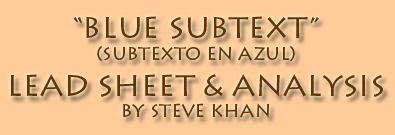

|
Soundclip:
|
|
Steve
Khan's
lead
sheet: 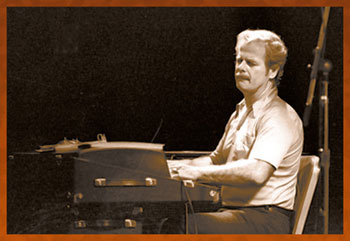 In the great Jazz tradition, players have taken a set of changes that they enjoyed playing over, and simply wrote a new melody, and gave this "new" composition a new title. As everyone has learned, you can't copyright chord changes! So, in the case of "Blue Subtext," I decided to just compose my own melody to these rather familiar changes, and this is what is now heard on the recording. In the great Jazz tradition, players have taken a set of changes that they enjoyed playing over, and simply wrote a new melody, and gave this "new" composition a new title. As everyone has learned, you can't copyright chord changes! So, in the case of "Blue Subtext," I decided to just compose my own melody to these rather familiar changes, and this is what is now heard on the recording.Over the many years, I have come to depend upon keyboard artist Rob Mounsey because of his superb musicianship, and for his affinity for the kind of harmonic approach that I feel closest to. On a tune like "Blue Subtext," I am asking Rob to, in essence, play and perform what is an arrangement. Though this offers some challenges, it is not the same as being asked to "just play, and be yourself." The latter is always most ideal for all of us who play. The recordings of Clare Fischer that inspired me the most were those where plays either Fender Rhodes, or some kind of contemporary keyboard. If you would now seek one recording that offers you a lot of this side of Clare Fischer, perhaps you might investigate his 1989 recording titled, "LEMBRANÇAS"(Concord Picante), which awakened my ears to other harmonic possibilities. His unique voicings on the electric keyboards caused me to wonder if it was even remotely possible to explore such things on the guitar. His voicing style has a way of speaking better on either of those electric instruments than on an acoustic piano. You could try any particular voicing or sonority and play it first on your keyboard with a Rhodes-like sound, and then go and play the exact same voicing on an acoustic piano, and I am confident that you would hear what I'm talking about. There's just a way that certain small clusters, or groups of intervals, blend on an electric keyboard, where they might not function the same way on an acoustic piano. There's probably a simple explanation for this, but better to seek that from a pianist! Anyway, the arrangement for Rob and the keyboard can now be accessed here, and you can see for yourself exactly what he had to deal with. For the better part of the piece, Rob was asked to play long, sustained chords almost exclusively. I enjoy hearing the sense of these beautiful sonorities floating over the wonderful Latin rhythms. In this case, when I asked timbalero, and my designated rhythm captain, Marc Quiñones what kind of Latin rhythm treatment this piece would get, he quickly replied, "It's a Son!" I knew, at the very least, that this meant that there would be the full compliment of Latin percussion: conga, timbal, and bongo. I also knew, before we began, that this would probably be one of the only pieces that came to me organically in 3:2 clave. To serve as an introduction, letter [I] attempts to embrace all the altered dominant 7th colors that I associate with Clare Fischer. In this case, they are all related to G7, which, of course, is the V7 for Cm7. If you have some basic keyboard skills, and can isolate and play any of these altered dominant sonorities, you will find that, in almost all cases, the thumb on each hand will be a 2nd apart, giving you a nice little cluster on the inside of the chord. At the top, when [I] first appears, the section is 16 bars long, but when it reappears after the guitar solo, [I2], it is 12 bars in length. During [I], it is really intended to just be a series of harmonic colors over the rhythms, I chose to only lightly orchestrate the chords by using my ESP Strat, and playing little 3 to 4-note voicings dialed-in via my Ernie Ball volume pedal. The fundamental structure of this tune is a repeating 16-bar form that, at times, can sound like a minor blues in C-minor, but, in bars 9-12, as a contrast, it puts you through a nice ii-V-I to Dbmaj7. One harmonic touch that is different from what is most familiar to everyone is that on beat 3 of bar 2, I added in a C7(alt.) chord to pull towards the ivm7 chord, Fm7. You will see, as each solo chorus goes by, that voicing is almost always new and different. On this chart or lead sheet, you can see that the melody sections were all labeled as letter [A]. However, as no keyboard artist would play the same exact thing each time for the other two appearances of the melody, I added in some rhythmic touches, variations, to bars 5-6 and 10-12. 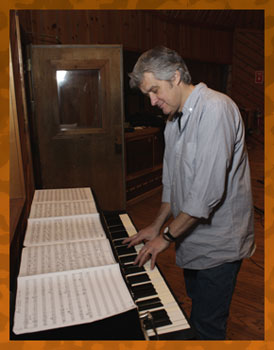 You won't see them on the lead sheets, but if you have the recording, you would certainly hear them. If you look closely at bar 5 and bar 13 on Pg. 2 of the keyboard lead sheet, you will see that the expected m7b5 chord, Dm7b5, is not there, and it has been substituted for by a D7(alt.) chord. It's not uncommon to do this, and to turn the expected iim7b5 chord into a V7 of the V7(G7) chord to create more harmonic motion. Here to accentuate the new melody, you see a descending sequence of triads in the right-hand, Bb to Ab, 1st inversions, followed by Eb to Db in root position. The small cluster in the left-hand in bar 6 for the G7(alt.) is something that I also associate with Clare Fischer. You will also see three different endings to the [A] section. The 1st Ending enables us to loop around and repeat the melody for what should be considered as [A2]. The 2nd Ending, out of that section, offers a solo break, and it serves to shoot the guitar into the solo section. You won't see them on the lead sheets, but if you have the recording, you would certainly hear them. If you look closely at bar 5 and bar 13 on Pg. 2 of the keyboard lead sheet, you will see that the expected m7b5 chord, Dm7b5, is not there, and it has been substituted for by a D7(alt.) chord. It's not uncommon to do this, and to turn the expected iim7b5 chord into a V7 of the V7(G7) chord to create more harmonic motion. Here to accentuate the new melody, you see a descending sequence of triads in the right-hand, Bb to Ab, 1st inversions, followed by Eb to Db in root position. The small cluster in the left-hand in bar 6 for the G7(alt.) is something that I also associate with Clare Fischer. You will also see three different endings to the [A] section. The 1st Ending enables us to loop around and repeat the melody for what should be considered as [A2]. The 2nd Ending, out of that section, offers a solo break, and it serves to shoot the guitar into the solo section.The solo section was conceived to have 6 choruses. As you will see, I labeled them as [B]-[B2]-[B3], and then [C]-[C2]-[C3]. On my original play-along, in truth, the concept really never went further than the various [B] sections. When you know that you're going to be playing Latin music with some of the greatest and most knowledgable players in the genre, you can't just stay in this floating texture from the Rhodes and not do something more rhythmic. What does that mean? It means that there has to be a montuno somewhere. This is really the first time that I had enough confidence to try to write montunos in 3:2 clave. I guess that they turned out O.K., because Marc never crossed a finger from each hand, and gave me the horrifying signal that something that I had written was cruzado, that I was out of clave. In an early draft of the keyboard part, I had only written out [C], and what was to become [C3], but when Rob sent it back to me, after listening to it many times, it just felt out of balance with what had appeared before. So, I had to sit down again, and compose a new montuno section that would then appear as a real [C2], and this is what you now hear. If we just focus in on letter [B] and you look at bar 7, this style of voicing I associate more with McCoy Tyner, Herbie Hancock and Chick Corea. Yes, the original play-along exercise was intended to be focused on Clare Fischer's harmonic style, but one can't escape the influence of other sounds that I hear, both on the keyboard, and on the guitar as well. It's also worth noting that in this chorus, in bars 5 and 13, the Dm7b5 sounds do appear each time. Notice that the sus4 and the b5 are clustered together in the left-hand. To add some variety and depth to the altered 7th chord sounds, in bar 9, over the Ab7, you see that we have the natural 9th and the b5, as well as the 13th. As gorgeous as this kind of sound can be, it usually means that one must play, in this case, the Ab Lydian b7 scale [Ab, Bb, C, D, Eb, F, Gb]. For me, in my way of viewing things, I would tend to think of it as Eb melodic minor, in the end, the notes are the same. During the 2nd chorus, [B2], in bars 5 and 13, you now see and hear the arrival of D7(alt.) as a substitute for Dm7b5. The first time that I became aware that this was even possible was when I was studying the Jazz genre of music during my college years at U.C.L.A.('65-'69), and I heard Chick Corea doing this on some standards on a pair of LPs titled: "JAZZ FOR A SUNDAY AFTERNOON"(Solid State). It was most apparent on the old standard, "Lullaby of the Leaves." I kept expecting to hear the m7b5 ii chord, and I kept hearing a V7(alt.) chord from Chick. The left-hand always seemed to be playing the Tyner-esque voicing for a D7#9 of F#-C-F, spelling up. Of course, if you are the pianist, and you're in complete control of the harmonic direction behind any soloist, within the bounds of good taste, you can play anything that is considered musical. So, as a guitarist, especially in a trio setting, this has always been something that I have added to my personal arsenal of options. 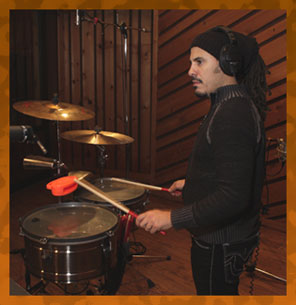 Again, in bar 7, you see voicings that I associate with McCoy Tyner, and those whom he influenced. But this time, the chords have gone up in register. In bar 11, there is a delayed resolution to the Dmaj7 chord, as a C/Db voicing appears on beat 1. What is so nice about this particular device is that the E-natural inside of the C major triad needs to resolve itself upwards to an F-natural to complete the process. This is always effective to these ears. The cadence to Cm7 offers another one of my favorite Tyner-isms, and that is that, as you resolve back to Cm7, for a moment, the left-hand plays a voicing that is most associated with F7(13). Keeping a 'C' on top in the right-hand, that voicing is followed by a voicing in 4ths, G-C-F, spelling up. Again, in bar 7, you see voicings that I associate with McCoy Tyner, and those whom he influenced. But this time, the chords have gone up in register. In bar 11, there is a delayed resolution to the Dmaj7 chord, as a C/Db voicing appears on beat 1. What is so nice about this particular device is that the E-natural inside of the C major triad needs to resolve itself upwards to an F-natural to complete the process. This is always effective to these ears. The cadence to Cm7 offers another one of my favorite Tyner-isms, and that is that, as you resolve back to Cm7, for a moment, the left-hand plays a voicing that is most associated with F7(13). Keeping a 'C' on top in the right-hand, that voicing is followed by a voicing in 4ths, G-C-F, spelling up.As [B3] begins, in bar 1, we see a more familiar version of the Tyner configuration in the left hand. In bar 7, there is a reprise of the sonority that opens the tune in letter [A], and that is where you have a Cm9(maj7). This time, however, the voice-leading guides us to a D-natural on top, and not the anticipated C-natural. In bar 5, you are given the expected Dm7b5, but, in bar 13, another variation of D7(alt.) appears. In the flow of harmony, this kind of variety can never hurt. In bar 9, during the ii-V to Dbmaj7, this time we have a different Ab7(alt.) sonority, Ab7(13b9b5). This particular sound often boxes a soloist into lines that must embrace aspects of the Ab 1/2-tone/whole-tone diminished scale. Here we would have: [Ab, Bbb/A, Cb/B, C, D, Eb, F, Gb]. The trick, when soloing, is to not allow yourself to sound like you are playing patterns too much. When playing over dominant 7th chords that feature the 6th/13th, 9th, and the b5, you have to be careful with your lines, because there are pitches that, in almost all other situations might sound great, will rub against these tones, and can even sound wrong. I am speaking mostly about, in this key, A-natural/Bbb(b9) and E-natural/Fb(#5). This final long-note chorus ends in bars 15-16, nicely in clave, as we are about to transition to 3 choruses of montunos. Up to this point, we have enjoyed hearing the full compliment of Latin percussion, including: conga, timbal, bongo, and güiro, but that is all about to change!!! When we hit the Chorus 4 and letter [C], as the montuno begins, Marc shifts to his mambo or salsa bell, Bobby's conga remains, but now the bongo bell, the campana makes it presence felt. The change in bells gives the tune a much more physical presence, and the montuno ratchets up the intensity level. In this 1st montuno solo chorus, bars 5 and 13 offer the sounds of Dm7b5. In bar 10, the Ab7 chord again presents the colors of 13b9. The Dbmaj7 voicing that you see in bar 11 is another piano sonority that I associate with Chick Corea. Often times, spelling-up, on the keyboard or the guitar, you would have: F-Bb-Eb-Ab-C. But, if you look carefully you can see that Chick has left out the Ab, which gives a wider spread to the harmony. On the guitar, it took me awhile to figure out just how I could play that, because including the Ab is so easy. It's just a barre and your 2nd finger. To accomplish the newer voicing, what I do is that I flatten my 3rd finger across my A-D-G strings, playing, in this case: F-Bb-Eb, and then, with my pinky, the 4th finger, I play the top C-natural. The broken-chord style of montuno is something that we hear all the time, except usually players are not attempting to do this in the style of Clare Fischer. For me, it is obviously much easier to write out this kind of piano montuno, because I never have to play it in real-time myself. One day, when Rob Mounsey and I were sitting together in his studio, either in pre or post-production, he confided in me by saying, "You know, no keyboard player could really play this, execute these voicings this way, because moving from one of these voicings to the next is very un-keyboard like - especially what happens between the thumbs and first fingers!!!" Ouch, that was hard to hear, but, when I looked more closely I knew exactly what he was talking about. Still and all, he did it!!! Bravo Rob!!! For the 5th Chorus of the guitar solo, the 2nd montuno chorus, letter [C2], I wanted to put to use a familiar rhythmical device that I certainly have heard in a lot of the modern Cuban music, like Los Van Van for example. To put it simply, you move into the '3' bar of the clave by playing on 4-and, and that last 8th-note is tied over into the 1st bar of the phrase. At times, I did this by putting to use small clustered groupings, and other times I featured the more traditional usage of 6ths. You can see the 6ths going into bars 5, 9, 11, and 13. This will almost always sound good. In bar 5, I put to use both Dm7b5 and D7(alt.) for 1/2 of the bar each. It looks like I changed something in bar 13, and what is labeled as D7(alt.) is really Dm7b5, so make a note of that if you are printing out the sheets. [C3], the last chorus of the solo, hits it hard with accents that everyone makes, as they are related to the 3:2 clave. In this chorus, bars 5 and 13 are each D7(alt.) bars. During the ii-V to Dbmaj7 in bars 9-12, within the Dbmaj7 chord bars, you have an F/Db resolving to Dbmaj7(9).  This kind of movement is also used frequently, and it offers, yet again, beautiful inner voice movement as the A-natural, part of the F major triad, moves down to an Ab as part of the Dbmaj7(9). Normally, for me, this voice would move up a 1/2-step to Bb. What is interesting here is that, in the left hand, that Bb does appear, so one could view this as an irregular resolution as the A-natural to Bb crosses registers. The solo ends with a nice break in bar 16, and then Marc Quiñones guides us into [I2], which is a 12-bar reprise of our original 16-bar Intro. This kind of movement is also used frequently, and it offers, yet again, beautiful inner voice movement as the A-natural, part of the F major triad, moves down to an Ab as part of the Dbmaj7(9). Normally, for me, this voice would move up a 1/2-step to Bb. What is interesting here is that, in the left hand, that Bb does appear, so one could view this as an irregular resolution as the A-natural to Bb crosses registers. The solo ends with a nice break in bar 16, and then Marc Quiñones guides us into [I2], which is a 12-bar reprise of our original 16-bar Intro.As we reprise our main melody during [A3], we finally take the 3rd Ending and the Coda, and now we are deep in the middle of a 16-bar vamp for a fade. This new section is labeled as letter [D]. On the original play-along, it was only 8-bars long, and was just intended to be hypnotic more than anything else. For the recorded version, after great thought, I decided to expand the section to 16 bars and, in bars 7 and 15, I would adjust the accents in 3:2 clave so that they would give both Marc and Dennis Chambers something to aim for as the sections built upon one another. Harmonically speaking, we are really in a rather ambiguous area of C-minor. The main sonority, which you see on the and-of-2 in bar 1, spelling up: G-C-D-F, you don't really see or hear an Eb anywhere, and yet, it always feels like C minor. I associate this kind of chordal sound with Herbie Hancock more than anyone else. Throughout the sections, you have this movement where F-natural stays on top, but the lower voices move down a half-step from Ab-Db-Eb to G-C-D. As we are playing over a C-pedal from the bass, I tend to view the voicing on beat 1 as being more of a brief reflection of Bbm7(sus) than anything else. In concept, the guitar was to be improvising over 4 repeats of this section, but the ending of [D4] would feature a "false ending" in bar 15, making it feel as though the tune has actually ended, but, with a 2-1/2 bar break, Marc Quiñones brings us back in with one of his world class avanicos, and suddenly we are into [D5], and the fade continues. Sometimes, in the days, weeks, and months that lead-up to a recording, in your imagination you can hear a world of possibilities for a particular tune when soloing or even a particular section. But, when it comes time to record, everything that might have been in your imagination can somehow slip away, and you're just left with whatever you're hearing at that moment. In this case, during this Fade, the [D] sections went completely in the direction of the blues language. Needless to say, that's just what felt right to me then. Periodically, you hear me putting to use my Korg DVP-1 Harmonizer which has been making appearances on my albums since 1989 and "PUBLIC ACCESS"(GRP). Back then, it was housed in a huge refrigerator-sized rack that I thought that I would be using for years with Joe Zawinul's Weather Update, but, as you all well know, that didn't happen!!! So, eventually I had all the various rack-mounted pieces of gear removed, and I tried to find a way to put some of them to use. The DVP-1 was important to me, because I just love having the option of employing my own little psychedelic big band. from time to time. Were it not for the electronics genius of Ralph Skelton [Zawinul's former keyboard tech], I never would have been able to use this device in real time, because it has no "bypass" switch or function. So, Ralph created a little bypass box for me, and that enables me to improvise, knowing that I could use the DVP-1 at any time. In the harmonizer mode, it has 7-8 banks, and within each one, I can store 8 voicings. 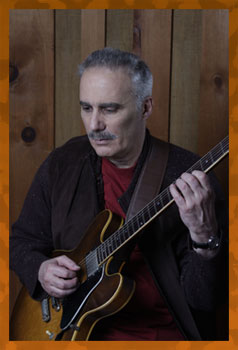 So, I have programmed into the DVP-1 lots of my favorite sonorities. Though I have shared this before, the trick is that I program, generally speaking, each voice BELOW the one that I'm actually playing, so my note is the top voice, and everything below follows it around parallel. I heard Zawinul doing this many times on his Prophet synthesizer, using the "Unison Lock" function. It always knocked me out when he did it!!! So, I have programmed into the DVP-1 lots of my favorite sonorities. Though I have shared this before, the trick is that I program, generally speaking, each voice BELOW the one that I'm actually playing, so my note is the top voice, and everything below follows it around parallel. I heard Zawinul doing this many times on his Prophet synthesizer, using the "Unison Lock" function. It always knocked me out when he did it!!!I remember the first time that I heard a harmonizer effect applied to an instrument in this way. In this case, it was Randy Brecker's trumpet solo during "The Purple Lagoon" from the Frank Zappa album, "ZAPPA IN NEW YORK," recorded in 1978. Here's what Zappa wrote in his own liner notes about this particular moment in the performance: It can be amusing sometimes that, when you sequence an album, even after so much thought, there can be tunes that were placed close together for the best of reasons, and yet, they can bear certain similarities that, had things been different, you might have wanted to keep them separated!!! For example, on "SUBTEXT," on each of the first 3 tunes: [1] "Bird Food" [2] "Blue Subtext" [3] "Baraka Sasa" I used the DVP-1. On "Bird Food" it only appears briefly in the [B] sections of each solo chorus. And, during "Baraka Sasa," it appears briefly for a phrase or two during the solo section. However, as you now know, it appears a great deal during the Fade of "Blue Subtext." I thought so much about the sequence of this album, and when all was weighed and measured, for me, this was the best possible order to present the music as one whole piece of work. But, after "Baraka Sasa," the DVP-1 never appears again during the CD. I guess if it had been that important of a consideration, I would have spread it out a little more. By comparison, the guitar lead sheet is quite simple. For the purposes of this presentation, I just decided to offer the melody page, which only includes letters [I] and [A], with all 3 endings. In the [I] section, you can view all of my guitar voicings that were played on my ESP Strat with a brighter setting than normal, and dialed-in via my Ernie Ball Volume Pedal, with a touch of the tremolo arm, the "whammy bar" - or the "soul stick"! When mixing in this color, the most important thing is to present it more as a sonic "shadow" than a featured instrument. The keyboard voicings should always remain as the most important thing. When I have performed this sound and function for other artists, even though, before leaving the studio that day or evening, I will demonstrate to them my concept of how this sound should be used, almost always, they end-up mixing the sound too loud. This, of course, is very disappointing! If you have studied the keyboard lead sheets for letter [A], you might have noticed that all the endings are written for bars 15-16. On the guitar lead sheet, because of some melodic changes, the endings are from bars 14-16. The most important bar 14 appears in [A2], and it is the one that you hear just before the 2nd Ending, which leads into the guitar solo. I had to write this in later for Rob Mounsey as it was not on the original lead sheet. As this particular lead sheet was so dense relative to the keyboard, I could not effectively present it as a mini-score, which is usually preferable for me. So, I thought that it would be a great thing to offer the bass part for this arrangement as well. Rubén Rodríguez remains as one of my favorite musicians, and he, as much as anyone else of his generation, understands the role of his instrument, and its part in the vast history of this rich genre. In my small way, over the years, I've learned a great deal about how the bass functions in the context of the music, but, there are still subtleties of which I remain unschooled. And, thank goodness, in those cases, Rubén just ignores what I've written, and plays what he knows to feel best. Lucky me!!! In general, when one is playing Salsa in cut-time, the bass is almost always playing the root of the chord that is coming on beat 4 of the bar before its arrival. It's amazing how this approach can sound so very natural while never seeming to clash with the harmony of that prior bar. I can't imagine how all the great bassists ever get used to doing this, and with such great time, feeling, and swing! Anyone could learn so much from Rubén's playing. He's a master, and one of the great, great people in music! This is one of the bass charts for the recording where it did serve as a good guide for Rubén, but as you will hear, he knew exactly where to be loose, and to take liberties. Other than discussions about how I wrote various section repeats, during the entire recording, we almost never discussed any specifics about notes. Again, I want to acknowledge how very grateful I am to both Marc Quiñones and Bobby Allende, who were so spectacular throughout, but for me, that they came-up with so many spectacular breaks over the course of the 9 songs on the album is one of the key elements to making recording really sound and feel like Latin music!!! In the end, I'm just so thankful that we could do this together! In case you haven't figured out just what the subtext of "Blue Subtext" might be, the truth is that this composition is based upon the chord changes to Kenny Dorham's "Blue Bossa," which first appeared on Joe Henderson's Blue Note album titled, "PAGE ONE" which also featured the great McCoy Tyner. So, there you go, mystery solved!!!
[Photo: Clare Fischer
Photos of: Rob Mounsey; Marc Quiñones; Rubén Rodríguez; and Steve By: Richard Laird @ Avatar Studios, January 30th, 2014 ] |